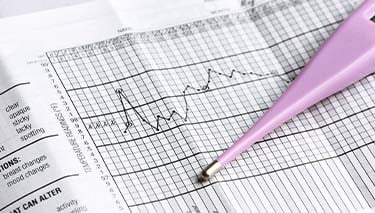Once you start paying attention to your body, it's amazing how many hints it delivers about the various stages in your cycle and ovulation symptoms can be quite noticeable and easy to detect once you learn what to look for.
Don t forget that any form of birth control using synthetic hormones (such as the oral contraceptive the pill , implants or injections) will suppress normal ovulation symptoms and other signs of the different stages in your menstrual cycle.
Ovulation symptoms can be quite subtle. They involve your body’s normal response to the natural changes in hormones that occur at different stages of the ovulation cycle.
These symptoms often happen before ovulation and give you some really good hints that you are in your most fertile period, the four or five days in the lead-up to ovulation. But remember, every woman is different. Her most fertile time will depend on her own individual cycle.
Some common ovulation symptoms are:
- increased libido (sexual desire)
- change in cervical mucous
- change in the position and firmness of cervix
- tender breasts
- heightened senses of smell and taste
- ovarian or pelvic pain (Mittelschmerz)
- rise in basal body temperature
Ovulation symptom: increased libido or sexual desire
Many women won’t be surprised by this ovulation symptom – and it certainly makes good sense biologically.
The increase in certain hormones in the lead-up to ovulation often triggers higher-than-usual sexual desire in women.
The hormones which can influence sexual desire at this time are oestrogen, testosterone and luteinising hormone.
If you’re planning to fall pregnant, this pre-ovulation symptom of increased female libido is good news, because you’re more likely to fall pregnant if you have sex as often as possible in the four to five days leading up to ovulation.
There are many anecdotal reports from women who believe that they look more sexually attractive in the lead-up to ovulation too; oestrogen can deliver plenty of side-effects that may contribute to this. Some women say they take more effort in their appearance during their most fertile phase.
Ovulation symptom: change in cervical mucous
The change in cervical mucous that occurs just prior to ovulation is one of the most consistent and reliable of ovulation symptoms in many women.
The volume of cervical mucous starts to increase as ovulation gets closer. Shortly after menstruation, cervical mucous may be sparse, but it will slowly increase in volume as the days progress. At first, it will usually have a slightly sticky consistency and be a white or cloudy colour.
In the days just before ovulation, the rise in oestrogen causes an increase in cervical mucous. The mucous at this time is usually fairly clear and the texture becomes more slippery and stretchy it is often compared to raw egg-white in colour and consistency.
The cervical mucous produced in the period before and during ovulation is designed to allow sperm to move freely through the cervix and into the fallopian tubes and to help its survival until the egg is released.
Ovulation symptom: a change in the position and firmness of the cervix
To recognise this sign you need to become familiar with the usual feel of your cervix.
Supporters of this method suggest checking the cervix once a day at around the same time. The cervix is usually smooth and round and slightly firmer than the vagina. It feels like the tip of your nose and is located at the top of the vagina. The cervix is more easily checked with one or two clean fingers, while in a squatting position.
When ovulation is close, the cervix will become higher (so can become more difficult to reach) and generally feels softer and more open.
Many women don t feel comfortable with checking the state of their own cervix, so this is an ovulation symptom that is not commonly self-assessed.
Ovulation symptom: tender breasts
Only some women experience this ovulation symptom, and it's generally thought to be a side-effect of high oestrogen levels. Women who experience breast tenderness will usually find it occurs in a similar pattern each month.
The effects of the oestrogen diminish significantly after ovulation however they may recur in the lead-up to menstruation.
If you experience breast tenderness mid-cycle, it's worth taking note of this as an ovulation symptom. Note when it occurs and to what extent, so that you can use it, along with the other ovulation symptoms as a guide to help you recognise your most fertile period.
Ovulation symptom: heightened senses of smell and taste
Some women report that they experience a greater intensity of smells and tastes when they ovulate. This can be due to an increase in oestrogen.
When the egg has been released at the time of ovulation and oestrogen levels drop, this symptom generally fades.
Ovulation symptom: abdominal cramps (Mittelschmerz)
An estimated twenty percent of women feel a mild cramp-like abdominal pain or twinge at the time of ovulation.
This ovulation symptom has the clinical name of Mittelschmerz, which is a German phrase meaning ‘middle pain.’
The pain can last from a few minutes to a few hours. Some women report pain on both sides of the abdomen and other women report that the pain moves from side to side each month.
Several possible explanations for the ovulation symptoms of mittleschmerz include:
- the growth of follicles in the ovaries prior to ovulation
- the rupture of the ovarian follicle that occurs each month at ovulation
- muscular contractions of the fallopian tube and the ovaries after ovulation
Ovulation symptom: rise in basal body temperature
Immediately after ovulation, a rise in the body's level of progesterone causes a rise in the body's basal temperature.
At this time, most women will experience a rise in their resting body temperature of around 0.5 degrees Celsius, often, their temperature will stay a little warmer for the rest of the month.
Basal body temperature is best measured first thing in the morning, before you get out of bed, using an accurate thermometer and recording your temperature on a chart each day.
By Fran Molloy, journalist and mum of four
Last Published* May, 2024
*Please note that the published date may not be the same as the date that the content was created and that information above may have changed since.





















